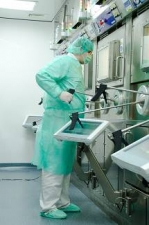Tektrotyd, a new medicine from Poland, registered in Europe
09-06-2016
The 99mTc-Tektrotyd preparation developed in NCBJ POLATOM Radiopharmaceutical Centre has been just authorised as a new medicine in almost all European Union countries. Due to some unique combination of features, including low price, an effective diagnosis of some cancers has become available to a wider range of oncology patients all over the world.
Some peptides have been used as molecules carrying 99mTc radioactive atoms. Tektrotyd is an original Polish invention, one of a few preparation of that type registered in the world as a medicine used to locate tumours and their metastases, to evaluate lesion nature and extension. Such data are key pieces of information indispensable to effectively plan the best treatment for individual oncology patients and/or to evaluate treatment results.
“99mTc-Tektrotyd is capable to image cancer processes at the sub-cellular level. The preparation is a Polish contribution to Molecular Imaging, a very dynamically expanding field of science that gave rise to a tremendous progress in medical diagnostics. Molecular Imaging helped to cure some diseases poorly or not at all curable by conventional methods/drugs” – pointed out Professor Krzysztof Kurek, NCBJ Director General – “Our product helps to improve the efficiency of detecting neuroendocrine tumours, a group of tumours very difficult from the medical point of view. Due to some unique combination of features, including low price, some new diagnostic procedures could have been introduced to routine clinical practice. We are very satisfied that other countries have just opened their markets to our product”.
The 99mTc-Tektrotyd radiopharmaceutical preparation is the first in Poland medicine, in which properties of some peptides capable to recognize specific receptors present in membranes of tumour cells have been used. Diagnostics is possible because of gamma radiation emitted by 99mTc radioactive atoms bound to molecules of the peptides; the radiation may be used to image distribution of tumour cells in the patient body. The preparation is useful in detecting neuroendocrine tumours, assessing their severity, and planning the best therapy in individual cases. Neuroendocrine tumours may develop from endocrine cells distributed all over the body. Majority of the tumours are located in the digestive tract or in pancreas. Tektrotyd may detect cancer cells at an early stage of their development; so-far such cancers were usually detected at some later stage and typically were already accompanied by numerous metastases. The Polish product may also be useful to detect other tumours exhibiting various expression of somatostatin receptors, such as breast cancer, melanoma, lymphoma, non-small-cell lung carcinoma etc.
Tektrotyd shipped to clinics does not contain 99mTc radioactive atoms, therefore it may be transported and stored without any concern about radiation protection or potentially negative impact on environment. In the clinic, some specialized personnel under supervision of a nuclear medicine physician combines content of two vials containing molecules of the carrier, then adds some precisely dosed amount of the technetium-99m radioactive isotope from a locally operated radionuclide generator. The preparation in intravenously injected to the patient. Molecules of the carrier are responsible for attaching to cancer cells, while gamma radiation emitted by 99mTc is used to image distribution of tumour cells throughout the patient body. The distribution is best visible between 2 and 4 hour after the injection. The patient need not be hospitalized. The administered substances are excreted in urine not giving rise to any side effects.
“R&D works on labelling somastatin analogues with radioactive isotopes with the objective to use them in oncology diagnostics have been performed in our Institute since 1996” – said Professor Renata Mikołajczak, NCBJ POLATOM Director Proxy for Scientific Matters – “They were successfully concluded in 2008, when our product (in the meantime named Tektrotyd) was admitted to the Polish market by Polish Ministry of Health. Since then the volume of Tektrotyd production has been steadily growing, and we have been witnessing ever growing interest in the product all over the world. Certificates of Registration issued in subsequent countries are the best confirmation of the interest”.
Awards won by NCBJ POLATOM Radioisotope Centre for Tektrotyd development and implementation include Honorary Mention granted by Minister of Science and Education (2006), winner of the Innovation of the Year contest (2008), the highest honour in the Polish Product of the Future contest (2008), gold medal on International Fair of Inventors, Research and New Technologies in Brussels (2009). Diagnostic merits of the preparation have been confirmed in numerous scientific papers written by physicians. Scientific reports have been verified by the market.
The just obtained Certificates of Registration cover the following European countries: Austria, France, Greece, Spain, Germany, Poland, Portugal, UK, Italy, Bulgaria, Czech Republic, Denmark, Estonia, Finland, Norway, Rumania, Slovakia, Sweden and Hungary.
More info:
Marek Sieczkowski
NSBJ Spokesman
phone +48 512 583 695
email: rzecznik@ncbj.gov.pl





